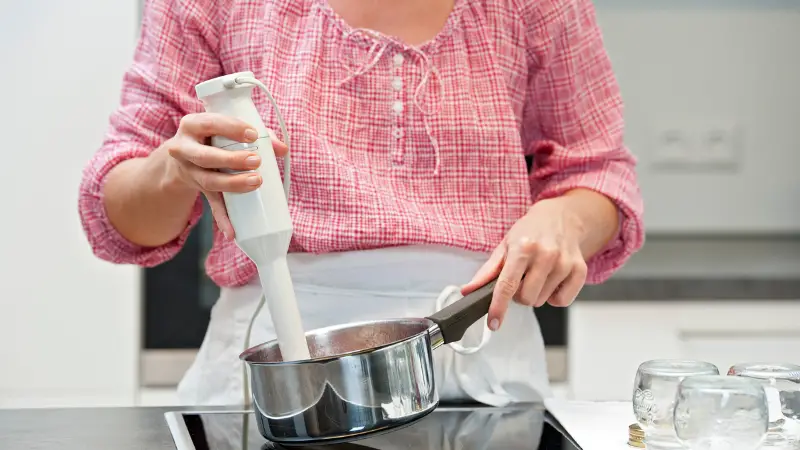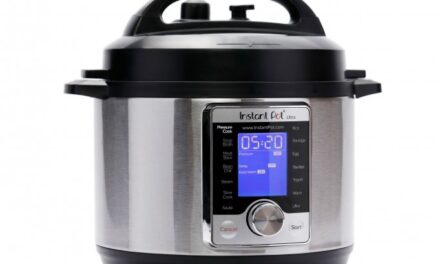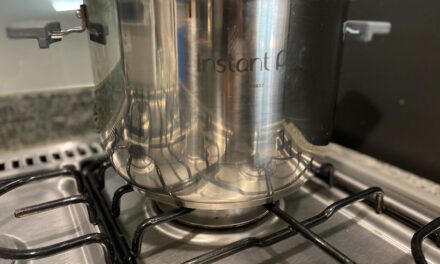Hand blenders, aka immersion blenders, make it quick and easy to blend or purée ingredients in the same container where they are being prepared. While this provides many benefits, you may be wondering about a potential mess.
On average, hand blenders can splash nearby surfaces, especially when stopping them. Exercising care with them can minimize that splashing and keep countertops splatter-free, as long as appropriate handling is used.
Hand blenders are a great addition to any kitchen, but the thought of splashing might keep you from purchasing one. Read on below to find out if this is a problem and how to manage it.
Do Hand Blenders Splash?
Hand blenders were originally invented in Switzerland and patented in 1950. This new appliance brought with it increased practicality in novel ways.
Being able to use the hand blender in the same container saved much time and cleaning but did add a potential splash.
Most people new to the kitchen will discover that hand blenders can cause a mess when in use.
Hand blenders can splash, but there are numerous ways of ensuring they won’t, like using a deep container and being careful with how you operate the hand blender. The more experience gained with them, and the less cleaning will have to be done after use.
Hand blenders are favored around the world as important kitchen tools that facilitate many recipes, from soups to sauces.
The splashing potential does not take away from their usefulness, and there are many ways to avoid a lot of the mess.
How to Use a Hand Blender Without Splashing
Adding a hand blender to your kitchen arsenal can be a great idea, but it is an appliance that may require a tiny learning curve.
You will quickly notice that the hand blender is prone to splashing, especially at the beginning and end of the process. To avoid splashing, you can:
- Use a deep container.
- Be careful with your movements.
- Wait until the blender is submerged before turning it on.
Let’s take a look at how to avoid many of the splashing causes.
Avoid Shallow Containers
If you notice that your hand blender is often splashing, take a look at the container you are using.
While the hand blender is a practical tool, it doesn’t mean that you can use just any container if you want to avoid splashing.
The most advisable course of action is to never reach for a shallow container.
A hand blender used in combination with a container with tall sides will provide the best results, especially when it comes to reducing cleaning time.
Some hand blenders include a bowl made specifically to avoid splashing, but don’t worry if you haven’t invested in new ones.
Any container with higher walls will do, especially if it has a cylindrical shape.
The higher walls will prevent much, if not all, of the splashing that may have occurred with normal bowls. This will help you enjoy the process more.
Control the Movement
To avoid splashing, you should consider how to best control your hand movement.
The most recommended tactic when using a hand blender is to use vertical motions from top to bottom.
It tends to be instinctive, using circular movements with a blender, but that will create a much higher risk of splashing.
You should also keep a tight grip on the blender throughout the process. Haphazard movements are more likely to create splashing.
Wait Until Submerged
Many hand blender users will feel the need to start it while plunging it into the ingredients.
You should avoid doing this as much as possible if you want to reduce splashing. If you start it too quickly, you may find yourself covered in the ingredients.
The best way to avoid this is to wait until your hand blender is submerged before turning it on, no matter if you are using wet or dry ingredients.
Use the Lowest Setting
You may be tempted to use higher speed settings with the hand blender so you can be finished sooner.
To avoid splashing, you should opt for low-speed settings and take some more time that will be saved during the cleaning process.
Especially at the start of blending, you should turn your hand blender to the lowest setting. If you feel in control, you can experiment with speeding it up later in the process.
Use the Right Angle
Angle is everything when it comes to reducing the risk of splashing with a hand blender.
You should keep your hand blender submerged as much as possible, and you should use vertical movement, but you should also keep it away from the bottom.
If you hit the bottom of the container, you are likely to cause splashing.
However, if you keep the hand blender submerged to an angle that is just shy of touching the bottom, you will significantly reduce the splatter.
You should also avoid holding the blender too close to the top once it is submerged. The right angle will keep the blender away from these risk areas.
Conclusion
Hand blenders can splash, but with the right techniques in use, you won’t have to bother with extended clean-up sessions.
With the tips and tricks presented here, your blending experience will be as smooth and clean as possible.





